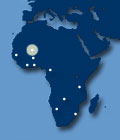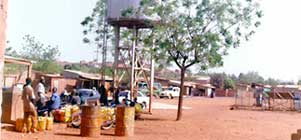|
||||||||||||
| Burkina Faso | Cameroon | Cote D’Ivoire | Ghana | Mali | Namibia | Senegal | Swaziland | Tanzania | Zambia | ||||||||||||
Information Source: Mali: Country Assessment Report. |
||||||||||||
|
||||||||||||
|
Context Summary Mali is one of the world’s poorest countries, with an estimated per capita income in 2000 of US$240, with population estimated at 10.6 million. Population density is 8.7 persons per square kilometer. The economy is predominantly agricultural, and crops depend almost entirely on irrigation or flooding from the Niger River, as 65 percent of the land is in desert or semi-desert areas. Past droughts set off waves of migration to urban areas, mainly to Bamako. Mali is heavily dependent on foreign aid and is vulnerable to fluctuations in world prices for cotton, its main export. According the Human Development Index (HDI), Mali is ranked 165th out of the 174 countries listed by UNDP in 2000. Life expectancy is estimated at 42.6 years. The urban population has grown at an annual average of rate of 5.2 percent between 1970 and 1995 and at 3.1 million makes up about 30 percent of the population. The main cities are Bamako, the capital district, with a population of 1,016,000 and five secondary cities between 50,000 and 100,000. The other cities in Mali have fewer than 40,000 inhabitants. In Bamako 45 percent of the population lives in precarious settlements because of difficulty tin accessing urban land; limited production of new plots; and high prices of serviced plots. Insecurity of land tenure has led low investment in the informal settlements. Mali's District of Bamako instituted 'Save Our Neighborhood', an informal settlement upgrading program, one year after the democratic election of 1992. Cost recovery proved to be a major hurdle. Only token amounts were charged for the right to settle on unoccupied land, and the government did not readily accept the proposed World Bank policy of cost recovery, service levels and construction standards for serviced plots, and size and shape of the plots. Lessons from Recent Projects - Summary Weakness of the 'Save Our Neighborhood' program
General lessons: Institutional Framework
Urban Upgrading and Land Legalization
Financial Aspects
Cost Recovery
|
||||||||||||
|
|
||||||||||||
| For more information: Click on: Foreword and Overview 1. Problems and Context 2. Current Situation 3. Policy Context and Institutional Framework 4. Upgrading Projects and Programs 5. Case Study 6. Lessons Learned 7. Challenges and Proposed Next Steps Annex A: Country and City Profiles Annex B: Bibliography Annex C: Contact Information Download for Printing: |
||||||||||||
| < Return to top > | ||||||||||||
|
||||||||||||


